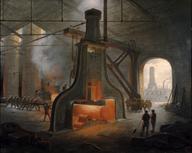

Homenaje de la Union Internacional de Telecomunicaciones a Gustave-Robert Kirschhoff
- Made:
- 1957 in United Kingdom
Printed tribute card with portrait commemorating Gustave-Robert Kirschhoff, created by the International Telecommunication Union, 1957. In Spanish. The card has four pages with the title on the front, tribute inside front page, portrait of Kirschhoff inside back - half length, turned to the right, in dinner dress.
One of a set of tribute leaflets with portraits commemorating figures who contributed to the development of telecommunications, produced by the International Telecommunication Union between 1955 and 1964. The ITU was formed in 1865 as the International Telegraph Union, a body to work internationally to prevent bottlenecks and disruptions across national borders by having twenty European states sign a treaty to agree common standards in telegraph signals and codes and to harmonize telegraph services. The group later expanded the scope of their agreements to incorporate new developments in communications such as radio, television and digital developments. Since 1947 the ITU has been a part of the UN as an international specialized agency for information and communication technologies to produce regulatory strategies and policies and an understanding of future technical, social and economic trends.
The leaflet text reads:
Homenaje de la Union Internacional de Telecomunicaciones a Gustave-Robert Kirchhoff
Galería de hombres illustres de telecommunicaciones
AÑO DE 1957
Gustave-Robert KIRCHHOFF
Físico alemán
1824-1887
Discípulo de F. Neumann en la Universidad de Koenigsberg, Kirchoff ocupó sucesivamente la cátedra de Física en las Universidaded de Berlin, Breslau y Heidelberg. En 1874 se hizo nuevamente cargo de la cátedra de Berlín, que desempeño hasta su muerte.
Kirchhoff elaboró en 1845 las dos leyes que asta nuestros días han constituido la base de la teoría de las redes eléctricas, y que se aplican lo mismo a la electrotecnia en general que la técnica de las telecomunicaciones por hilo. Estas dos leyes, que se complementan mutuamente, permiten, con relación a la teoría clásica de Maxwell (1873), una mayor simplificación de los casos de redes electro- magnéticas en régimen estacionario o quasi estacionario. Los trabajos de Kirchoff se extienden a todos los aspectos de la física contemporánea. Compartió con Bunsen (1859) la invención del análisis espectral, y sus investigaciones en óptica le permitieron definir el cuerpo negro y descubrir, entre otras, la ley fundamental que lleva su nombre sobre la emisión y la absorción de las radiaciones. El investigador Kirchhoff encontró en la teoría un medio para describir los distintos fenómenos más bien que para explicarlos, concep ción ésta de la enseñanza de la física que no ha dejado de influir en la filosofía y en la teoría del conocimiento de su siglo.
Details
- Category:
- Art
- Object Number:
- 2019-143
- Materials:
- paper (fibre product)
- Measurements:
-
overall (open): 227 mm x 315 mm x 1 mm,
overall (closed): 227 mm x 158 mm x 2 mm,
- type:




